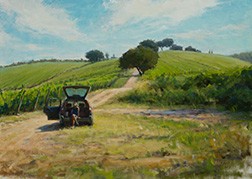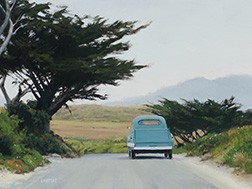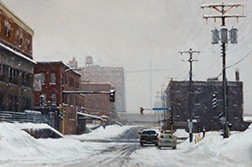Questions & Artists: Carl Bretzke
- Share
- Tweet
- Pin
- Share

“Vineyard Backroad” oil on linen.
I found Carl Bretzke and his wonderful paintings at least six months ago. I was immediately drawn to his paintings as a result of his meticulous compositions and his masterful use of values. I mentioned his name to several people I paint with on a regular basis and they had the same positive reaction to his work. Bretzke lives and works in the Minneapolis area and paints throughout the United States. He regularly competes in plein air competitions at the highest level and has won many awards. I was happy to find out that he is an invited artist to this year’s Peninsula School of Art’s Plein Air Festival and look forward to watching him paint in the upcoming event. His website is CarlBretzke.com.
Randy Rasmussen (RR): Carl, first, congratulations on being an invited artist to this year’s Door County Plein Air Festival (presented by Peninsula School of Art). Have you ever been to Door County?
Carl Bretzke (CB): Never. I have no idea what to expect, which is kind of exciting because I’ve heard good things.
RR: What is your first memory of drawing and painting?
CB: Probably first grade. There was a shy kid next to me at lunch that was always drawing pirate ships. I thought they were so cool! My first real experience doing art was in high school. I had an enthusiastic art teacher who also was a photographer. I ended up being the yearbook photographer and then continued taking drawing classes through college, receiving an art minor from the University of Colorado.
RR: I think I found you before the Peninsula School of Art. I found your work stunning, always seemingly enhanced by shadow. How would you describe your work?

“Last Ferry” oil on linen.
CB: Stunning and enhanced by shadow (kidding). Actually I tell people I’m a realist painter but not a photorealist. Photorealism seems too mechanical to me. I prefer bordering on impressionism more and more but with accuracy.
RR: You are a medical doctor and an artist. How often are you able to paint?
CB: I try to paint every day, anywhere from one to 10 hours. I am currently working as a physician half time to allow more time to paint. Three years ago while working full time as a physician, I was taking seven painting or drawing classes each week. I have lots of catching up to do.
RR: What is the most important thing you learned from your instructor, Joseph Paquet?
CB: You can never draw well enough, and value (as it relates to form) trumps color. Work to balance all of my skill sets and paint as much as possible from life.
RR: Can you give our readers the names of several other artists who you feel have influenced your work?
CB: Kristie Bretzke (my artist wife) is certainly one of my biggest influences and critiques my work and my manners almost daily. Joe Paquet, Ben Fenske, Marc Dalessio, Scott Lloyd Anderson, Richard Abraham, Daniela Astone, Bob Upton and Jim Robinson.

“Vintage Truck – Carmel, CA” oil on linen.
RR: When I look at your paintings, your handling of light, I think, makes your paintings distinctive. Many of the great painters I have been able to interview say they try to paint “light falling on objects.” Do you agree?
CB: I honestly think we are all painting the light on objects. Some are better at it than others. I try to see gradations of light on objects whenever possible.
RR: What is your current palette and has it changed over the years?
CB: Shockingly, I use 15 colors: 13 colors along the prismatic spectrum and two others that I added to shortcut some mixing. It is the “prismatic palette” I learned from Joe Paquet, who learned it from John Osborne who I think learned it from DuMond.
RR: Do you mix your greens?
CB: I do mix my own greens using Joe Paquet’s technique. I usually start with “middle green” which is a 50:50 mixture of ultramarine blue and cadmium yellow light. To that mixture I can modulate the warmth with other cadmiums and push greens into the distance by reducing warmth and by usually adding blue violet and white. Being partly left brain, a little science appeals to me. As greens in the light move away from me, they will lose yellow and move towards violet so I will add the other cadmiums sequentially down the prism, hence the utility of the prismatic palette.
RR: I know you have competed in some of the most important plein air events in the United States. Do you have a favorite place to paint?
CB: In the U.S., I love California and especially Carmel. There is everything there to paint and the weather is great. In my travels, I like Italy – same colors and light as California but with old world architecture and odd cars. Since a lot of my work is urban or slightly offbeat, I believe I can be equally happy painting just about anywhere if the weather is reasonably comfortable. That brings up “winter painting.” Painful but rewarding.

“Snow Day In The Warehouse District” (studio painting) oil on linen.
RR: Do you see yourself in the future becoming a full-time painter?
CB: Based on hours worked, I probably am now. Nonetheless, I hope to transition completely to painting in the next one or two years.
RR: Has your work changed during the past five years?
CB: Like everyone, I would like to think so. I am working hard at being a technically better painter to more easily express what I see. As my skills improve, my confidence improves. Confidence is one of the less talked about attributes of good painting but I think it is important when mixed with the proper amount of humility. As far as specifics go, I think my color variation and color as value has improved especially in foreground shadows. I’m starting to better see the big shapes before the small shapes which has helped me unify my compositions.
RR: Thank you.


